|
|
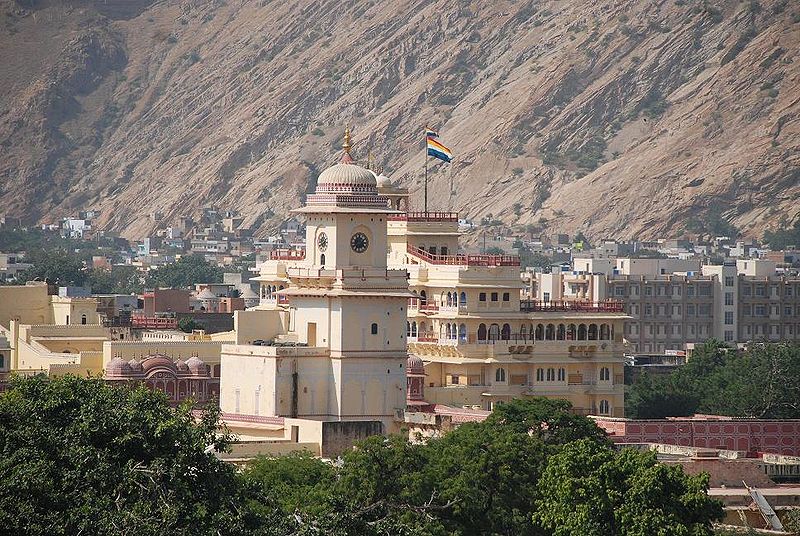 |
|
City Palace
Jaipur |
|
Introduction of Jaipur |
|
Jaipur is
a busting capital city and a business centre with all metropolis of
modern Rajasthan but still flavoured with an age old charm that never
fails to surprise a traveler. The old jaipur painted in pink can
attract any visitor with admiration. It is the vibrant capital city of
Rajasthan.
It covers an area of about 64.75 square km and is situated at an
elevation of 431 meters above sea level. This city sits on dry lake
bed in a dry landscape which is enclosed by the Aravallis and
protected by the Nahargarh Fort. Some of the buildings in the old city
are in pink color due to this Jaipur is popularly known as the "Pink
city".
Best Season to visit Jaipur is from November to March. Common
languages which spoken in Jaipur are Rajasthani, Marwari, English and
Hindi.
In summers the temperature is about 45 degree Celsius and it is
about 7 degree Celsius in winters. Temperature in Summers is around 45
degree Celsius and in winters it is around 7 degree Celsius. |
|
|
|
History of Jaipur |
|
The royal
city of Jaipur owes its name, foundations and careful planning to the
great warrior and astronomer, Maharaja Sawai Jai Singh II who was a
Kachwala Rajput. He ruled Jaipur from 1699-1744. The ancient capital
of Rajasthan was Amber, which lies at a distance of 11 km from Jaipur
but in 1727 the foundation of Jaipur was laid and from Amber the
capital was shifted to Jaipur. Maharaja Sawai Jai Singh II felt the
need of shifting his capital city with the increase in population and
shortage of water. Jaipur is the first planned city of India and the
King took huge interest while designing this city of victory. Maharaja
Sawai Jai Singh II of the Kachchwaha clan of Rajputs ruled the city
from the year 1699 to 1744. In this land, towering forts were built to
protect the capital from the enemy and battles were fought by the
great rulers. |
|
|
|
Tourist Attraction in Jaipur |
|
Prominent
tourist attractions in Jaipur are
Amber Fort, Nahargarh Fort,
Hawa Mahal,
City Palace,
Jaigarh Fort,
Jantar Mantar,
Laxmi Narayan Temple,
Albert Hall,
Galata Ji,
Jal Mahal, Raj Mandir
(Movie Theatre) and
Rambagh Palace.
Nahargarh Fort is located on the edge of the Aravalli Hills
overlooking the pink city of Jaipur. From the fort amazing view of
jaipur city can be seen.
Raj Mandir Cinema is a well-known movie theater in Jaipur. |
|
|
|
 |
 |
|
City Palace |
Albert Hall |
 |
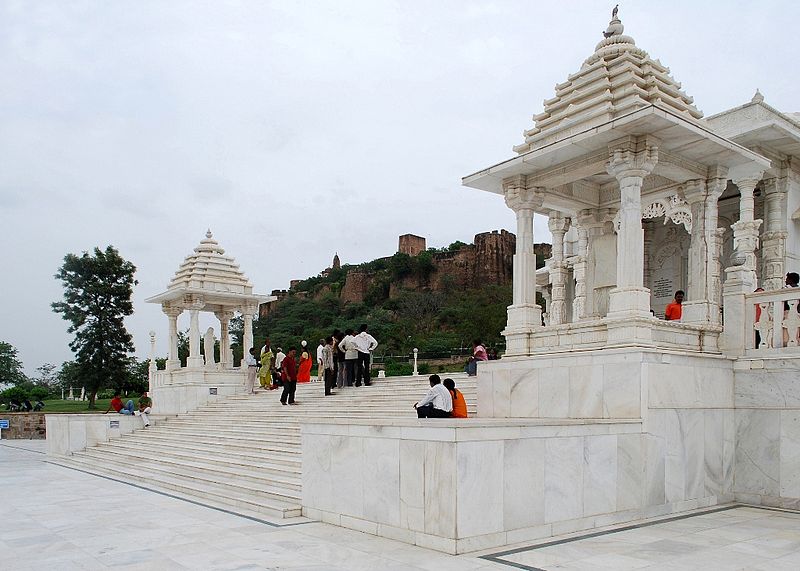 |
|
Amber Fort |
Laxmi Narayan Temple |
 |
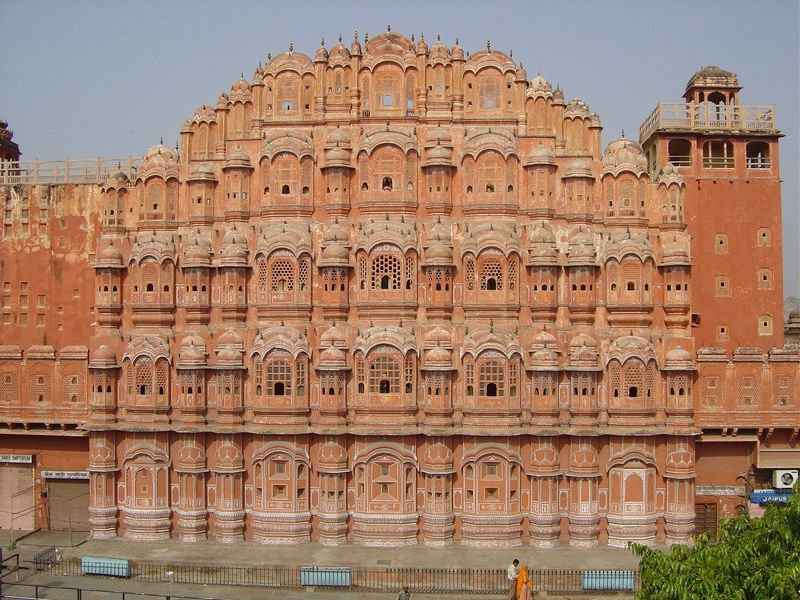 |
|
Galta Ji |
Hawa Mahal |
 |
 |
|
Jaigarh Fort |
Jal Mahal |
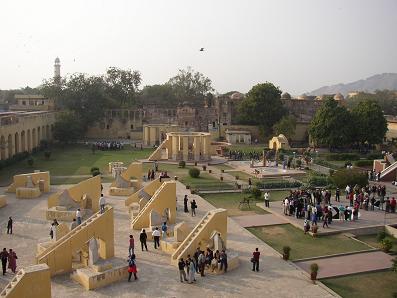 |
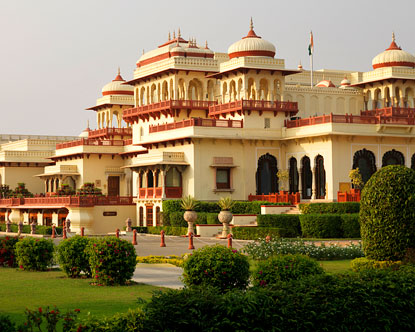 |
|
Jantar Mantar |
Rambagh Palace |
JAIPUR (Places of Interest)
Surrounded by embattled walls with rugged hills on three sides, Jaipur,
the rose-pink capital of Rajasthan, is one of the most picturesque cities
in India and a favourite with tourists.
Jaipur is situated on the Delhi-Ahmedabad route of the Western Railway. It
is 307 km. (191 miles) from Delhi, 1,118 km. (695 miles) from Bombay via
Ahmedabad (broad gauge) and 1,157 km. (719 miles) via Sawai Madhopur (metre
gauge). Good metalled roads connect it with Delhi and Agra. A regular air
service places Jaipur within a brief flying time from Delhi.
Jaipur takes its name from its founder, Sawai Jai Singh (1699-1743), a
prince, soldier, astronomer and builder. While still a boy of thirteen,
Jai Singh succeeded to the throne of Amber, the former capital of the
Kachhawa Rajputs. He was well-versed in Sanskrit and Persian and was
deeply interested in mathematics and astronomy. He wrote several treatises
on astronomy, law and history. The great observatories at Jaipur, Delhi,
Ujjain and Banaras still bear witness to his scientific genius.
Jai Singh ascended the throne of Amber in 1699 when Aurangzeb, the great
Mughul, was the ruling monarch in
Delhi.
There is an interesting story about the first meeting between the two. As
was the custom in those days, the new ruler went to Delhi to pay his
respects to the Emperor. In the durbar hall, as Jai Singh raised his hand
to proffer his presents to the Emperor, Aurangzeb unexpectedly flew into a
temper of rage. He jumped from his seat and thundered forth ‘‘Your
ancestors gave us much trouble and were disloyal. Now, say, what you
deserve of me before saying what you desire.” For a brief moment, Jai
Singh looked almost stunned. Then, Aurangzeb, firmly grasped both the
outstretched hands of the prince in his right hand and in an ironic tone
continued. “Tell me what use are your arms now?”
‘‘Your Imperial Majesty,” replied Jai Singh calmly, “during a wedding, the
bridegroom takes the bride’s hand in one of his own and he is duty bound
to protect her for life. Now that the Emperor of India has taken my two
hands in his right hand, what have I to fear! With your Majesty’s long
arms to protect me, what other arms do I stand in need of?”
So
greatly was Aurangzeb impressed by the young ruler’s presence of mind and
ready wit that he drew him near the throne and said: “You excel your
ancestore, Jai Singh I, in intelligence and ability. Indeed, you are Sawai
(one-and-a-quarter times) Jai Singh”. Let this be the title for you and
your successors.”
Soon after he came to the throne, Jai Singh realised the need for moving
the seat of his government from the hill-girt
palace of
Amber which was the capital of his ancestors for almost six centuries. He
had come to feel that the changed pattern of life under the impact of new
social and economic forces had made Amber unsuitable as the capital for
the future. Moreover, the methods of warfare had also undergone a change
and it was no longer considered necessary to seek security in mountain
fortresses.
Sawai Jai Singh, therefore, decided to build a new and much larger city on
the plains adjoining the range of hills at Amber. The foundations of
Jaipur were laid in November 1727.
Jai Singh’s one ambition was to make Jaipur one of the best planned
cities of his time. Accordingly, he obtained the plans of some of the
renowned European cities and then made a plan for Jaipur in consultation
with the famous astronomers, mathe maticians and architects of his time.
The city was built in accordance with the principles of town-planning laid
down in the Shilpa Shastras, the ancient Hindu treatises on architecture.
Since it was first built by Jai Singh, the city has been improved and
beautified from time to time.
The city is surrounded on all sides, except the south, by rugged hills,
many of which are crowned with forts and towers. The imposing Nahargarh
Fort tops a precipitous hill to the north-west. Also known as
Sudarshangarh, it was built by Sawai Jai Singh in 1734 for defence against
the attacks of the Marathas. Connected with Jaigarh Fort as Amber, it
commands a panoramic view of the valley below.
Rectangular in form, the city is divided into blocks by main roads running
north to south and east to west. The blocks are further divided by
narrower streets. The main roads are more than
33 m.
(110 ft.) in width and the secondary ones about 16 m. (55 ft.). A
crenellated wall, about 6 m. (20 ft.) high and 2 m. (9 ft.) thick, enclose
the city. It is pierced by 8 gateways. Of the same design, the gateways
with two kiosks above the entrance have pink facades worked with white
designs.
Even after 200 years, the city retains much of its old charm and
atmosphere. Its wide streets are flanked by houses with latticed windows.
Their rose-pink colour lends enchantment to the scene which appears almost
magical at sunset. In the streets of Jaipur, the visitor will see
contrasts which no other town in India can offer. The pavement shops
contrast strangely with the elegant business premises on the ground floor
of the multi-storeyed buildings. The colourfully dressed men and women
from the rural areas mingle with the intellectual and the office workers
in Western attire, while the camel, so indispensable in Rajasthan, looks
at the latest brand of automobiles with dignified unconcern. While
Jaipur is modernising quickly, particularly since it became the capital of
Rajasthan in 1949, it retains much of its old world charm and a touch of
the Arabina Nights atmosphere.
Palaces
The City Palace, enclosed by a masonry wall, occupies a seventh of the
city’s area. It is entered from the south by the Tripolia Gate and from
the east by the Sireh-ki-Deorhi Gate which is the principal entrance. The
buildings surrounding the outer court, called the Jaleb Chowk, once housed
the personal establishment and offices of the Maharaja. Of the many
notable structures inside the Palace enclosure, the Mubarak Mahal, was
built by Maharaja Sawai Madho Singh II in 1900. Its exterior is adorned
with delicate carvings on marble for which Jaipur is justly renowned. In
the midst of the adjoining pink coloured court stands the Diwani-i-Khas or
Hall of Private Audience. The building was used on cere- monial occasions.
The Diwan-i-Am or Hall of Public Audience – reminiscent of the old
princely grandeur – consists of a big hall with double rows of marble
columns supporting scalloped arches, and a gallery on one side screened
with jali. From the gallery, the royal ladies used to witness the court
ceremonials. The ceiling, pillars and arches are embellished with floral
design in gold and other colours in the traditional Jaipur style. Formerly
a durbar hall, it now houses the Pothikhana or the Maharaja’s private
collection of rare paintings and manuscripts. The present
Rajasthan
State was inaugurated in this Hall on March 30, 1949, by the late Sardar
Vallabhbhai Patel, one of the leaders of modern India.
The paintings, some of them among the best specimens of Rajasthan’s art,
include the portraits of the members of Jaipur’s royal houses, the dancing
Radha and
Krishna and the Ragmala series – pictorial representation of the different
ragas. Outstanding among the manuscripts in the library is the Razmnamah,
a Persian translation of the Mahabharata by Abul Fazl, Emperor Akbar’s
friend and historian. The text is illustrated with paintings in the
Persian style by the renowned artists of Akbar’s court. The manuscript
bears the impress of 11 seals affixed by the imperial library. Books
written by Sawai Jai Singh and also the translation in Sanskrit of the
Arabic version of Euclid’s Elements of Geometry (Rekha Ganit) are
available in the library.
To the
north-west of the Diwan-i-Khas is the stately Chandra Mahal, a
seven-storey cream-white structure towering majestically above the
surrounding buildings. The apartments in this palace, built by different
rulers from time to time, are sumptuously adorned with paintings and
floral decorations and have mirrored walls and ceilings. The ground floor
(Chandra Mandir), built by Sawai Jai Singh is decorated with large mural
paintings of the Kachhawa rulers. The walls and ceiling of Shobha Nivas
are studded with hundreds of coloured mirrors which
produce a
charming and brilliant effect. A fine view of the city, the surrounding
hills and forts is obtained from Mukut Mandir which crowns the palace.
The armoury (Silehkhana) within the palace has, perhaps, the finest
collection of old arms in
India.
The sword of Maharaja Man Singh, the renowned Rajput general of Akbar,
weighing about eleven pounds, is an interesting exhibit.
To the north of Chandra Mahal is the famous temple of Govindji, the
guardian deity of the rulers of Jaipur. The idol was brought by Sawai Jai
Singh from Mathura to save it from Emperor Aurangzeb’s iconoclastic fury
and installed in 1734.
Outside
the Mubarak Mahal, in the palace compound, is the Jaipur Observatory,
popularly known as Yantra, the largest and best preserved of the five
observatories built Sawai Jai Singh. Described as a most surrealistic and
logical landscape in stone, the massive masonry instruments in the
observatory are unique in design. They were designed to measure, among
other things, the local time, the Sun’s declination, azimuth and altitude;
the declination of fixed stars and planets, and to determine the eclipses.
There is also a large sun-dial.
Jai Singh – Scholar and
Scientist
Sawai Jai Singh had an intimate knowledge of the works of Hindu and Muslim
astronomers and kept himself posted with the progress of the science in
Europe. In his research, however, he did not follow the European
astronomers. He had his own scheme of research and the great observatories
he built may be described as monuments to a remarkable personality. Such
was his passion for astronomy that he used to spend long hours in watching
and recording the movements of the heavenly bodies and compared his
observations with those of other observatories in order to arrive at the
most accurate results. On learning about the advancement of astronomy in
Portugal, Sawai Jai Singh sent his own men, with one of the Portuguese
missionaries, to the court of King Emmanuel, who sent his envoy Xavier
D’Silva with De La Hire’s tables to Jaipur. In his library could be seen
the works of all the important astronomers from Arya Bhatt, Brahma Gupta
and Bhaskaracharya in India down to Ptolemy, Ulugh and De La Hire in West
Asia and Europe.
Sawai Jai
Singh’s almanac has given him a high place among the astronomers of the
world. Known as Jaz-i-Mohammad Shahi, after Emperor Mohammad Shah, it can
be seen in the library of the City Palace. |
|
|
How to Reach Jaipur |
|
By Rail:
Jaipur is linked by rail with important trains on its principal
networks. The main pride of Jaipur is Palace on Wheels, the Royal
Train. This special luxury train starts from Delhi and takes a round
trip of Rajasthan.
By Road:
Jaipur is well connected by road to all the major destinations of
India. An excellent road network facilitates comfortable travel to and
from Jaipur. Ordinary buses, Deluxe Buses, and AC coaches are
available for the convenience of the passengers. Main bus station of
Jaipur is Sindhi Camp Bus Stand which is about one km from the Jaipur
Railway Station.
By Air:
Jaipur is connected with major metropolitan cities of India like
Kolkata, Bombay, Madras, and Delhi. It is also linked with other
cities of Rajasthan through regular flights of Jet Airways, Sahara
Airlines and Indian airlines. |
|
|
|
|
|
 31 Days
Rajasthan Tour (Including Jaipur)
31 Days
Rajasthan Tour (Including Jaipur)

31 Days / 30 Nights
Delhi - Alwar - Deeg - Bharatpur -
Fatehpur Sikri - Agra - Dholpur - Ranthambore - Tonk - Bundi -
Jhalawar - Kota - Bijolia - Chittorgarh - Dungarpur - Banswara -
Udaipur - Rajsamand - Nathdwara - Kumbhalgarh - Ranakpur - Mount Abu -
Rohetgarh - Jodhpur - Jaisalmer - Bikaner - Nagaur - Mandawa - Sikar
- Jhunjhunu -Jaipur - Delhi
 28 Days Rajasthan Heritage
Tour (Including Jaipur)
28 Days Rajasthan Heritage
Tour (Including Jaipur)

28
Days / 27 Nights
Delhi - Agra - Fatehpur Sikri - Bhandarej - Jaipur - Mandawa - Bikaner
- Gajner - Jaisalmer - Jodhpur - Rohetgarh - Deogarh - Ranakpur -
Mount Abu - Udaipur - Dungarpur - Chittorgarh - Kota - Ranthambore -
Bharatpur - Delhi
 24 Days Forts and Palaces Tour
(Including Jaipur)
24 Days Forts and Palaces Tour
(Including Jaipur)

24 Days / 23 Nights
Delhi - Agra - Fatehpur Sikri - Bhandarej - Jaipur - Mandawa - Bikaner
- Gajner - Jaisalmer - Osian - Jodhpur - Ranakpur - Mount Abu -
Udaipur - Kota - Ranthambore - Bharatpur - Delhi
 19 Days Rajasthan and North
India Tour (Including Jaipur)
19 Days Rajasthan and North
India Tour (Including Jaipur)

19 Days / 18 Nights
Delhi - Shekhawati - Bikaner - Jaisalmer - Osian - Jodhpur - Ranakpur
- Udaipur - Pushkar - Jaipur - Fatehpur Sikri - Agra - Khajuraho -
Varanasi - Delhi
More....... |
|
|
|
Map of
Jaipur |
|
 |
|
|
|
|
|
|
|
|
|